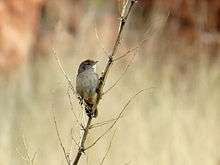Spinifexbird
The spinifexbird (Poodytes carteri) is endemic to inland Australia. Also known as Carter's desertbird, it is named after Thomas Carter, an English ornithologist and pastoralist active in Western Australia from 1887 to 1928.[2]
| Spinifexbird | |
|---|---|
 | |
| Scientific classification | |
| Kingdom: | Animalia |
| Phylum: | Chordata |
| Class: | Aves |
| Order: | Passeriformes |
| Family: | Locustellidae |
| Genus: | Poodytes |
| Species: | P. carteri |
| Binomial name | |
| Poodytes carteri North, 1900 | |
| Synonyms | |
|
Eremiornis carteri | |
Description
It has a rich brown cap, golden brown streaked wings, and a long tail. Both sexes are alike.
Behaviour
Its diet comprises a variety of insects and seeds collected in "spinifex" or Triodia grass. This species flies weakly, with its tail drooping. It tends to be solitary, and therefore is not migratory. The breeding season of the spinifexbird stretches from August to November and the nest is a shallow cup built in clumps of Triodia grass close to the ground. It usually contains two eggs. Not globally threatened, the species may be common in suitable habitats, although it is rarely seen due to the remote and arid nature of its habitat.
References
- BirdLife International (2012). "Eremiornis carteri". IUCN Red List of Threatened Species. 2012. Retrieved 26 November 2013.CS1 maint: ref=harv (link)
- McCarthy, G.J.; Walker, Rosanne (2017). "Carter, Thomas (1863 - 1931)". Encyclopedia of Australian Science. eScholarship Research Centre, The University of Melbourne. Retrieved 23 February 2018.
